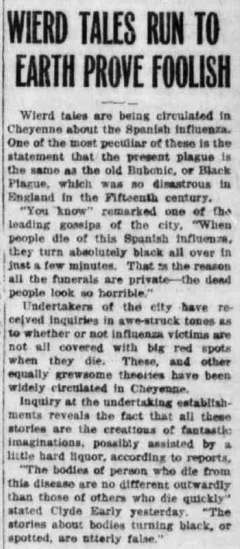Thanksgiving, a pandemic and some rumors

In the fall of 1918, Wyoming, like the rest of the United States, experienced the deadliest two months yet of the influenza pandemic then sweeping the world. From October 1918 through January 1919, 780 people in Wyoming died either of the flu or a combination of the flu and pneumonia. For weeks, newspapers across the state ran front-page obituaries of local people. The peak came during the first two weeks of November; by Thanksgiving, the onslaught of new cases and deaths seemed to be tapering off slightly—in some towns at least.
“Thanksgiving Day in Buffalo this year was observed,” the Buffalo Bulletin reported, “but in a very quiet manner, prevalence of the flu making it entirely out of the question to hold any public gatherings. A number of small dinner parties among friends and neighbors were given, so that a spirit of thanksgiving prevailed in the city to a certain extent.” That caution, the wariness in the tone of “to a certain extent,” seems particularly familiar now. It runs through all the Wyoming papers we browsed recently to find out what was up during Thanksgiving week, 1918.
In its “School Notes” column, the Newcastle News-Journal warned: “Sophomores, beware! Do not eat turkey wings, because the turkey ‘flu.’” Did the joke mean tensions were easing? Was it a sign of pandemic fatigue, so familiar to all of us these days, when Wyoming COVID deaths have reached 202 and our number of cases per capita is second highest in the nation?
On Thanksgiving 1918 the Cheyenne-based Wyoming State Tribune ran a particularly interesting brief on flu rumors headlined “Weird Tales Run To Earth Prove Foolish.” The report quoted one of Cheyenne’s “leading gossips,” who remarked, “‘When people die of this Spanish Influenza, they turn absolutely black all over in just a few minutes. That is the reason all the funerals are so private—the dead people look so horrible.’”
People had been asking undertakers “in awe-struck tones” whether influenza victims were “covered with big red spots when they die. . . These and other equally grewsome [sic] stories have been widely circulated in Cheyenne,” the report continued. Not true, said undertakers, adding, “all these stories are the creations of fantastic imaginations, possibly assisted by a little hard liquor. . . The stories about bodies turning black, or spotted, are utterly false.” Well, that’s a relief, at least.
But for much more on how Wyoming coped with the flu in 1918, read Phil Roberts’s article, “The 1918 Flu: A Pandemic Sweeps Wyoming.” For a look at more wild rumors about the flu circulating in the U.S. Army as World War I came to a close, read Tom Rea’s article, “Bob David's War: A Wyoming Soldier Serves in France.”
We hope that a “spirit of thanksgiving” will prevail in your household, too, even if only “to a certain extent.” Stay safe.
